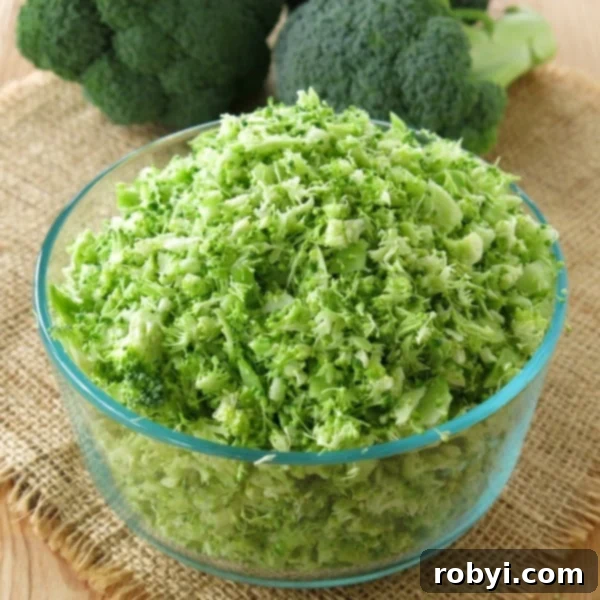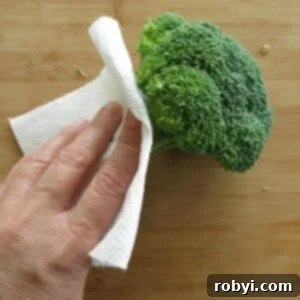Unlock a world of healthy, low-carb, and gluten-free culinary possibilities by mastering the simple art of ricing and freezing broccoli. Much like its popular cousin, cauliflower rice, riced broccoli has rapidly become a go-to ingredient for those seeking nutritious, grain-free alternatives that don’t compromise on flavor or convenience. Imagine whipping up a delicious meal in just 5 minutes using ready-to-cook broccoli rice from your freezer – a true game-changer for busy weeknights!
This comprehensive guide will walk you through every step, from preparing fresh broccoli to perfectly ricing it and storing it in your freezer for future use. Not only will this technique save you precious time when dinner calls, but it’s also a fantastic way to stretch your grocery budget by utilizing an often-overlooked part of the vegetable. The best part? You don’t need to blanch broccoli rice before freezing it, making the process even simpler!
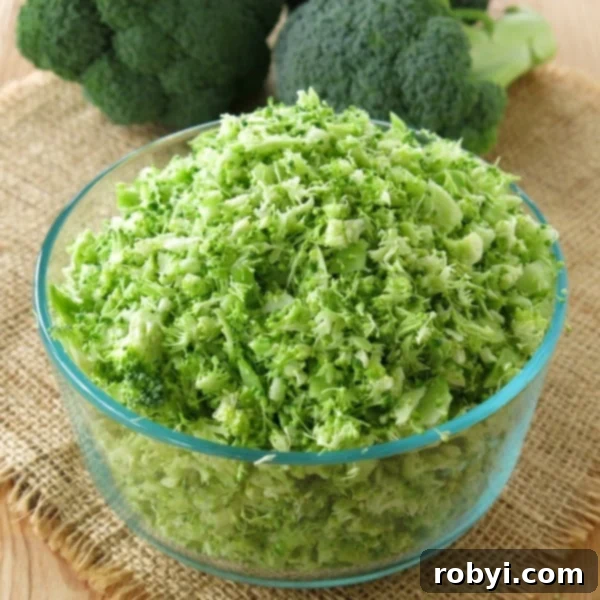
Why Choose Riced Broccoli? Health Benefits and Culinary Versatility
Riced broccoli has found a special place in our kitchen, initially making a grand entrance in the form of delightful Broccoli Muffins. These were an instant hit, much like our beloved Cauliflower Muffins. The secret? Even the most staunch broccoli “haters” find it hard to resist a cheesy, savory egg muffin subtly packed with finely chopped broccoli. This innovative presentation of broccoli is a brilliant way to transform a common vegetable into something new and exciting.
Transforming the texture and appearance of broccoli is a clever strategy to encourage everyone, especially children or picky eaters, to consume more of this incredibly nutritious cruciferous vegetable. Beyond its appeal to selective palates, riced broccoli offers a fantastic grain-free solution for those following ketogenic, paleo, or gluten-free diets, allowing them to enjoy dishes like pizza crusts or casseroles without the added carbs.
The benefits don’t stop there. One of the most compelling reasons to embrace riced broccoli is its incredibly short cooking time. While traditional whole grain rice might simmer for 20 minutes or more, riced broccoli can be perfectly warmed and ready to serve on the stovetop in mere minutes. It’s a healthy, convenient, and incredibly versatile ingredient that deserves a permanent spot in your culinary repertoire.
Nutritional Powerhouse
Broccoli is renowned for its impressive nutritional profile. It’s an excellent source of Vitamin C, a powerful antioxidant, and Vitamin K, essential for blood clotting and bone health. It also provides a good amount of fiber, which aids digestion and promotes a feeling of fullness, making it an ideal component for weight management. Furthermore, broccoli contains folate, potassium, and various potent antioxidants and anti-inflammatory compounds, contributing to overall health and well-being. By ricing it, you retain all these valuable nutrients while offering a novel way to enjoy them.
Getting Started: How to Prepare Broccoli for Ricing
Before you begin the ricing process, proper preparation is key to achieving that desirable fluffy, rice-like texture. Follow these steps to ensure your broccoli is perfectly primed:
- Rinse Thoroughly: Wash your head of broccoli under cool running water to remove any dirt or debris.
- Dry Extremely Well: This is arguably the most crucial step! Excess moisture on the florets or stalks will lead to a mushy, rather than fluffy, end product. After rinsing, vigorously shake off as much water as possible. Then, pat the broccoli dry with a clean kitchen towel or paper towels. For best results, consider using a salad spinner to remove any lingering moisture.
- Separate Florets from Stalks: Use a sharp knife to carefully cut the florets away from the thick main stalk. Aim for medium-sized florets, as they will be easier to process evenly.
Can You Rice Broccoli Stalks? Don’t Throw Them Away!
Absolutely, broccoli stalks are completely edible and should not go to waste! They have a slightly firmer texture and a milder flavor than the florets, adding a wonderful dimension to your riced broccoli. In fact, we love using them to create delicate “ribbons” for our refreshing Broccoli Stalk Salad. Including the stalks in your riced broccoli not only reduces food waste but also boosts the overall fiber content.
To prepare the stalks for ricing, follow these simple steps:
- Trim Rough Ends: Cut off any very dry or discolored ends of the stalk.
- Peel the Outer Layer: The tougher outer layer of the stalk can be fibrous. Use a sharp paring knife or a vegetable peeler to carefully remove this waxy exterior, revealing the tender, lighter green interior.
- Chop into Segments: Once peeled, cut the stalks into roughly 1-inch (2.5 cm) pieces. These smaller segments will process more easily and uniformly in your food processor or with other ricing methods.

Can You Rice Frozen Broccoli (Before Thawing)?
This is a common question, and the answer is generally no. You cannot effectively rice broccoli that has already been cooked or previously frozen as whole florets and then thawed. When cooked or thawed from a frozen state, broccoli becomes too soft and holds too much moisture. Attempting to rice it at this point will result in a mushy, pureed consistency rather than distinct, fluffy “grains” of rice. The key is to start with fresh, crisp, and very dry broccoli. However, as we’ll soon discover, you absolutely CAN freeze broccoli once it has been riced!
Mastering the Art: How to Rice Broccoli
Ricing broccoli is a straightforward process, and you have several easy methods at your disposal. The best method depends on the kitchen tools you have and the quantity of broccoli you need to rice.
- Food Processor (Recommended Method): This is by far the quickest and most efficient way to rice broccoli, especially when preparing larger batches for freezing or meal prepping.
- How To: Add your prepared (washed, thoroughly dried, and segmented) broccoli florets and stalks to the bowl of a food processor fitted with the S-blade. Do not overfill the processor; it’s better to work in batches to ensure even ricing.
- The Pulse Technique: Secure the lid and pulse the processor in short bursts, typically 5-10 times. You want to pulse until the broccoli breaks down into small, rice-sized granules.
- Key Tip: Resist the urge to continuously run the processor, as this will quickly turn your broccoli into a paste or puree. Err on the side of under-processing; you can always pick out any larger pieces and pulse them again or finely chop them with a knife. The goal is a light, airy, and uniform texture.
- Knife (Manual & Precise): If you don’t have a food processor or only need a small amount of riced broccoli, a sharp chef’s knife can get the job done.
- How To: Place your broccoli florets and prepared stalk pieces on a large cutting board. Using a rocking motion, finely chop the broccoli until it resembles small grains of rice.
- Pros & Cons: This method offers excellent control over the consistency of your rice but is significantly more time-consuming and labor-intensive than using a food processor.
- Box Grater (Simple & Accessible): A standard box grater can also be used, making this method accessible even without specialized equipment.
- How To: For this method, you can keep the florets attached to a portion of the stalk, as the stalk provides a convenient handle. Using the medium-sized holes of your box grater, rub the broccoli against the grater over a bowl or cutting board.
- Tip: Be careful when you get to smaller pieces to avoid grating your knuckles! This method produces a slightly finer rice consistency.
- Blender (Alternative with Caution): While less ideal for a truly “dry” rice texture, some blenders with a good pulse function can also work.
- How To: Place small amounts of broccoli into your blender. Use short, sharp pulses. You may need to stop frequently to scrape down the sides and redistribute the broccoli to ensure even processing.
- Caution: Blenders can be prone to over-processing and turning broccoli into a smoothie if not handled carefully.
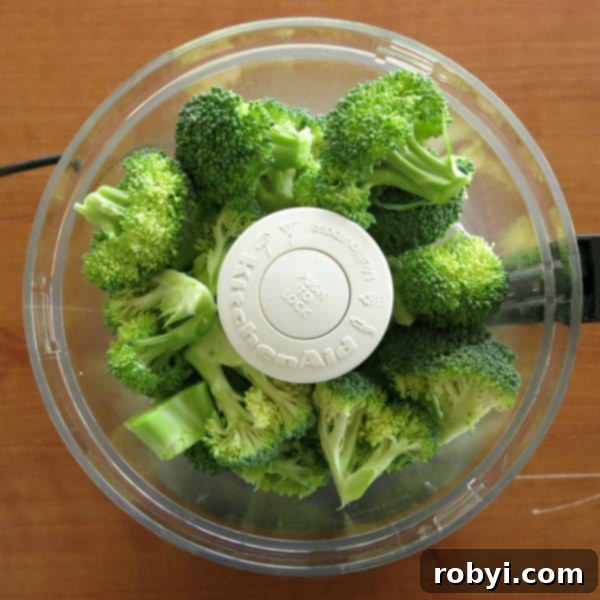
Yield and Storage: Maximizing Your Broccoli Rice Harvest
Understanding how much riced broccoli you’ll get from a fresh head and how to store it properly are crucial for efficient meal planning and preventing waste.
How Much Does a Head of Broccoli Yield?
Fresh broccoli is commonly sold in 1-pound (approximately 450-gram) packages at most grocery stores. This weight typically includes the stalks. Depending on the size of the heads, a 1-pound package might contain anywhere from 2 to 3 individual heads of broccoli.
From a single 1-pound head of fresh broccoli, you can expect to yield approximately 4 to 5 cups of riced broccoli. This yield can vary slightly based on whether you choose to include the stalks and their overall size. This generous yield means a single purchase can provide multiple servings of a versatile, healthy ingredient.

Storing Riced Broccoli in the Refrigerator
If you plan to use your riced broccoli within a few days, the refrigerator is the perfect place for short-term storage. This is an excellent strategy for weekly meal prep, allowing you to have a ready-to-cook vegetable on hand.
Simply transfer the freshly riced broccoli into an airtight container. When stored correctly, it will remain fresh and vibrant in your refrigerator for 2 to 3 days. Beyond this period, it might start to lose some of its crispness and fresh flavor, so it’s best to use it promptly or opt for freezing.
The Ultimate Convenience: How to Freeze Riced Broccoli
This is where riced broccoli truly shines as a fantastic meal prep ingredient! Unlike whole broccoli florets, which typically require blanching before freezing to preserve their color and texture, finely chopped broccoli rice has a different set of rules. The fantastic news is that riced broccoli does not need to be blanched before freezing!
Here’s how to freeze riced broccoli for maximum convenience:
- Portioning: Measure out your riced broccoli into desired portions. We recommend 1-cup or 2-cup servings, as these are common amounts for recipes.
- Packaging: Transfer the measured portions into high-quality, resealable freezer bags. Alternatively, you can use freezer-safe containers, but bags tend to be more space-efficient.
- Remove Air: Before sealing the bags, try to press out as much excess air as possible. This helps prevent freezer burn and maintains quality.
- Labeling: Crucially, label each bag with the date it was frozen and the quantity of broccoli rice inside. This ensures you use older batches first and know exactly how much you have.
- Freeze Flat: For best results and easier storage, lay the freezer bags flat in your freezer until they are solid. Once frozen, they can be stacked vertically to save space.
For the best quality, aim to use your frozen riced broccoli within 2 months of freezing. While it will remain safe to eat for longer, its texture and flavor may start to degrade after this period.
The remarkable benefit of frozen riced broccoli is that you often don’t even need to defrost it before using it in most recipes! Just like with Frozen Cauliflower Rice Recipes, which offer guidance for making pizza crusts, egg muffins, roasted rice, and more, the exact same convenient process applies to frozen broccoli rice. Simply add it directly to your pan, microwave, or oven from frozen, and cook until tender.
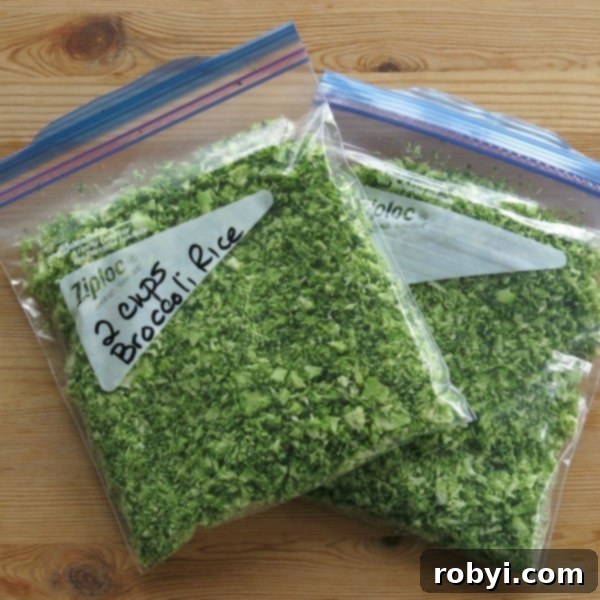
Delicious Ways to Enjoy Riced Broccoli: Recipes and Culinary Ideas
Riced broccoli is incredibly versatile and can be incorporated into a multitude of dishes, serving as a healthy side, a base, or a flavorful addition. Here are some of our favorite ways to use this nutrient-packed ingredient:
- Quick Stove-top Side Dish: This is perhaps the simplest and quickest way to enjoy riced broccoli.
- How To: Heat a skillet over medium-high heat with a drizzle of olive oil. Add minced garlic (optional) and your riced broccoli (fresh or frozen). Toss to coat, cover the skillet, and cook for about 5 to 7 minutes, stirring once or twice, until tender-crisp. Remove the cover, season generously with salt, black pepper, and any other desired herbs or spices.
- Flavor Boosters: A squeeze of fresh lemon juice, a sprinkle of red pepper flakes, or a dash of soy sauce can elevate the flavors.
- Effortless Microwave Method: Perfect for a single serving or when you’re truly short on time.
- How To: Place your riced broccoli in a microwave-safe bowl with a teaspoon or two of water. Cover the bowl (with a lid or microwave-safe plastic wrap, leaving a small vent). Cook on high for 3 to 4 minutes, then stir and check for tenderness. Cook for additional 30-second intervals if needed. Season to taste.
- Flavorful Roasted Broccoli Rice: Roasting brings out a deeper, slightly nutty flavor in broccoli.
- How To: Toss riced broccoli with olive oil, salt, pepper, and your favorite seasonings (garlic powder, onion powder, paprika). Spread it in a single layer on a baking sheet and roast at 400°F (200°C) for 15-20 minutes, stirring halfway, until tender and slightly browned. For a detailed recipe, check out our Roasted Broccoli Rice.
- Nutrient-Packed Broccoli “Muffins” or Egg Bites: A fantastic way to make broccoli appealing to everyone.
- How To: Mix riced broccoli with whisked eggs, shredded cheese (cheddar or mozzarella work well), diced onion or bell pepper, and your favorite seasonings. Spoon the mixture into greased muffin tins and bake until set and golden brown. These tot-sized muffins are perfect for breakfast, snacks, or lunchboxes. Find the full recipe for our delightful broccoli muffins.
- Healthy Base for Bowls: Use riced broccoli as a low-carb alternative to grains in Buddha bowls, poke bowls, or grain bowls. Top with your favorite protein, roasted vegetables, and a delicious sauce.
- Stir-Fries and Curries: Add riced broccoli towards the end of cooking your favorite stir-fry or curry for an extra boost of nutrients and a pleasing texture.
- Soups and Stews: Stir a handful of riced broccoli into hearty soups or stews during the last few minutes of cooking for added substance and flavor. It can also be partially blended into creamier soups for extra vegetable content without altering the texture too much.
- Low-Carb Pizza Crusts or Fritters: Combine riced broccoli with an egg and some cheese to form a “dough” for a healthy, low-carb pizza crust, or shape it into savory fritters and pan-fry until golden.

Tips for Success and Troubleshooting
To ensure your riced broccoli experience is always a success, keep these expert tips in mind:
- Dryness is Divinity: We can’t emphasize this enough – dry broccoli is happy broccoli! Any residual moisture will lead to a soggy, undesirable texture.
- Pulse, Don’t Process: When using a food processor, use short, quick pulses. Over-processing is the enemy of fluffy broccoli rice, quickly turning it into a paste.
- Don’t Be Afraid of Stalks: They’re edible, nutritious, and contribute to the overall yield. Just remember to peel the tougher outer layer.
- Season Generously: Broccoli, whether riced or whole, loves flavor. Don’t be shy with salt, pepper, garlic, and other spices after cooking.
- Batch and Freeze: If you’re going to the trouble of ricing, make a larger batch than you immediately need. Having pre-portioned bags in the freezer is a huge time-saver for future meals.
- Cook from Frozen: For most applications, there’s no need to thaw frozen riced broccoli. Just add it directly to your hot pan or microwave.
With these guidelines, you’ll be a riced broccoli pro in no time, ready to enjoy its myriad benefits and delicious versatility!
If you loved this guide and found it helpful, please consider rating this recipe and tagging @DinnerMom or #DinnerMom on social media. We always enjoy seeing your culinary creations!
Recipe: How to Rice Broccoli and Freeze It

How to Rice Broccoli and Freeze It
Learn how to easily rice and freeze broccoli to make healthy, low-carb, and gluten-free recipes in minutes. No blanching required!
Rated 5 out of 5 stars by 2 votes
Print Recipe
Pin Recipe
Rate Recipe
Course: Side Dish
Cuisine: American
Prep Time: 15 minutes
Total Time: 15 minutes
Servings: 4 cups
Author: Marjory Pilley
Equipment
- Food processor
- Resealable freezer bags
Ingredients
- 1 pound Broccoli (including stems)
Instructions
Wash and thoroughly dry broccoli.

Cut broccoli florets from stalks.

Remove outer layer of the stalks with a vegetable peeler or knife and cut into 1-inch pieces.

Add broccoli florets and stalks to a food processor and pulse several times until the broccoli is finely chopped, scraping sides if needed. Work in batches if necessary.

Store riced broccoli in an air-tight container or bags in the refrigerator or freezer until ready to use.

Notes
Store riced broccoli in the refrigerator for up to 3 days or in the freezer for up to 2 months for best quality.
Grab 5 Low-Carb Sauces: And Get More Tips for a Healthy Kitchen JOIN HERE
Nutritional and Food Safety Disclaimer
